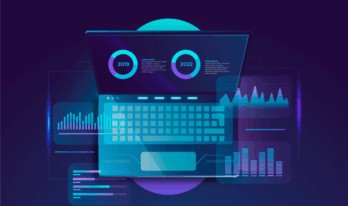Augmented Analytics and its best practices help businesses improve data analytics, data sharing, and business intelligence. Moreover, it develops more efficiency in the process of data analysis.
We certainly live in a world where data plays an important role in procuring insights. Further, probing data and multiple sets of data is challenging yet attainable with the right tools.
Augmented Analytics and its best practices also help transform working models for business intelligence. As a result, in this current age where data is an asset, procuring and collecting actionable insights from it has become a priority.
Although there are very few data scientists available. Therefore, companies are now investing in Augmented analytics to gather actionable insights.
Moreover, Augmented analytics is set to grow with a CAGR of 25 % and could reach the market value of $ 22.4 billion by 2025.
Hence, in this article, we will delve into understanding Augmented Analytics and its best practices for businesses. Although, we must first understand the term Augmented Analytics.
Understanding Augmented Analytics and its Best Practices
What is Augmented Analytics?
According to Gartner, “Augmented analytics is the use of enabling technologies such as machine learning and AI to assist with data preparation, insight generation, and insight explanation to augment how people explore and analyze data in analytics and BI platforms. It also augments the expert and citizen data scientists by automating many aspects of data science, machine learning, and AI model development, management, and deployment.”
Augmented Analytics refers to using AI, Machine Learning, and NLP to automate the process of data analytics. Moreover, it incorporates data science and artificial intelligence to make the process of data analytics simple and accessible.
Further, Augmented Analytics integrates into data analytics life cycle stages. It also probes, analyzes, comprehends, and pursues the information from the data. Further, it transforms, homogenizes, and automates the use of data for users.
Augmented Analytics also develops more efficiency in the process of data analysis. Hence, it helps companies with tools to edge ahead of their competition.
It also enables the practical usage of various data processing techniques to analyze a wide range of data. Moreover, it improves the method of analyzing data by implementing complex algorithms to model behaviors, identify trends, and predict business actions.
Moreover, Augmented Analytics comprises of the following techniques:
-
-
- Augmented Data Preparation
- Automated Analytics
- Natural Language Generation and Natural Language Processing
- Machine-led Insights
-
Key Capabilities of Augmented Analytics
Here are the key capabilities of Augmented Analytics that businesses should know of:
- Augmented Data Preparation:
Augmented Analytics depends on Machine Learning features like automation to enhance the process of data analysis. Moreover, it automates, joining, profiling, tagging and annotating the data before data preparation. Hence, it provides quality data by automating repetitive transformations and integrations.
- Autogenerating and Analyzing Segments or Clusters:
With machine learning abilities, Augmented Analytics automatically searches for new segments and clusters in a data set. Hence, it helps categorize data for various purposes and requirements.
- Autogenerating Forecasts and Predictions:
Augmented Analytics uses machine learning to generate forecasts and predictions. Moreover, it analyzes multiple data sets in a business to learn and detect patterns for quick results.
The Benefits of Augmented Analytics and its Best Practices
Augmented Analytics and its best practices integrate components of machine learning and artificial intelligence. Moreover, it helps gain insights, analyze data from various angles, enhance productivity, and make better decisions. Hence, here are the beignets of Augmented Analytics:
- Automating Analysis:
Augmented Analysis significantly reduces manual labor to analyze complex data sets. It also automates the execution of insights to alert users for quick actions.
- Quick Data Preparation:
Augmented Analytics and its best practices integrate data from various sources. Moreover, algorithms automate data analysis by identifying schemas. It quickly transforms the data for reliable analysis prior to data preparation.
- Enhancing Data Literacy:
Augmented Analytics tools use NLP to help comprehend discoveries and automates the analysis of outcomes. Therefore, this helps increase and enhance data literacy. Hence, it creates a data-oriented environment that benefits the business in the long term.
- Discovering Opportunities:
Previously, BI tools required an idea or hypothesis to discover insights. However, Augmented Analytics uses algorithms to execute and provide contextual suggestions to discover newer insights.
- Better and Faster Decision-Making:
A report about software developers and IT leaders by Reveal states that 41% of businesses see an increase in access to data and analytics. That is to say, a leading cause of this was the ability to make data-driven decisions.
Moreover, Augmented Analytics automates the process of data preparation and rapidly provides data-driven insights for decision-making.
Key Challenges
Here are some key challenges businesses may face by adopting Augmented analytics:
- Accuracy and Reliability:
It is pivotal to ensure the insights from the tools offer accurate and reliable. Hence, using comprehensive data changes must be free of errors while updating models.
- Applicability:
Often users lack the time to segregate data and eliminate irrelevant information. Hence, it is important to assess the data to ensure relevant outcomes.
- Data Quality Training:
Above all, businesses must procure the right set of data to train analytical tools. It is also important to monitor and update tools to maintain the quality of insights.
- Execution and Scalability:
Moreover, Augmented Analytics requires plenty of computing power that depends on the platform and features. The volume of data also primarily influences the response time.
Here are the Best Practices to Successfully Implement Augmented Analytics
- Range and Adoption:
Firstly, it is important for businesses to comprehend the range of augmented analytics from natural language search and insights in decision-making. Businesses also need to make sure employees are adopting augmented analytics by studying the target audience.
- Objections and Leverages:
Moreover, Businesses must learn and comprehend primary objections while using BI and analytics tools. Further, they can leverage the information to identify and counter potential objections.
- Start Compact and Regulate KPIs:
It is important to keep the data compact while beginning with data analysis and artificial intelligence. Moreover, businesses can execute and align KPIs to gain higher business value.
- Integrate Processes:
Businesses often face a lack of transparency while using AI for data analytics. Therefore, it is important to invite employees from various departments to participate in analytics initiatives. Hence, this develops trust and reliability in the insights.
- Persuade a Data-Driven Environment:
Businesses must certainly ensure strategies and training are accessible to encourage maximum usage of data assets. Moreover, it also persuades employees to utilize data analytics in regular processes.
- Discover Newer Insights:
Above all, businesses must increase the usage of augmented analytics and its capabilities to discover the newer potential for actionable insights. Further, encourage the adoption of augmented analytics.
Conclusion:
In conclusion, Augmented Analytics and its best practices will influence and transform user experience with data analytics and BI Tools. Moreover, there are multiple examples of augmented analytics in the Finance, Manufacturing, Retail, and Healthcare industries. It also enables businesses to rely on insights from machine learning and natural language for competitive advantages.
Recommended For You:
Understanding Augmented Analytics and its Benefits to the Business




